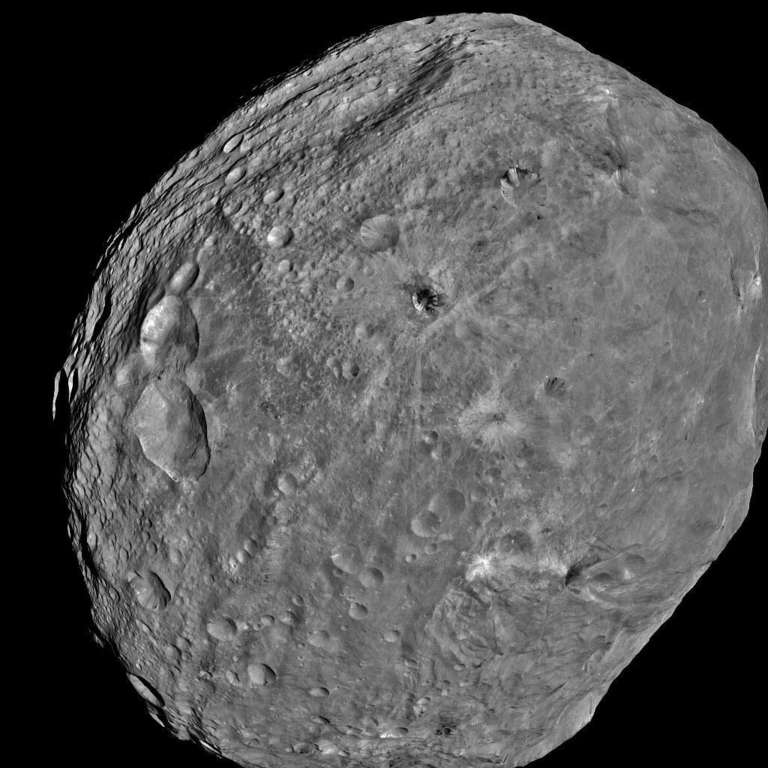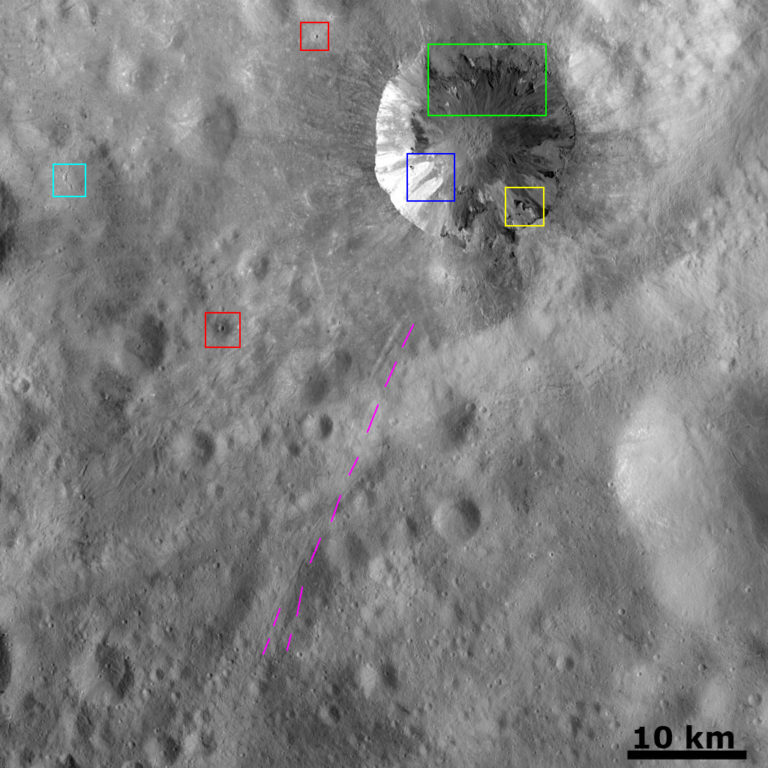Emily Lakdawalla • Oct 11, 2011
Lovely pic of a recent crater on Vesta
With little fanfare, the Dawn mission continues releasing a new picture from Vesta every day. I forget to check up on them very often because they don't have an RSS feed for their new images (though they do show up on the "new images" page on JPL's Planetary Photojournal, which is where I usually find them). There is going to be more fanfare tomorrow, though, because there will be a Dawn press briefing originating from the annual meeting of the Geological Society of America tomorrow at 10:00 Pacific / 18:00 UTC. It will be Webcast live; I'll be watching and Tweeting, and will likely post a writeup later.
Anyway, getting back to the images, this one is definitely my favorite among their recent releases, a closeup on one of Vesta's strange streaky bright craters. It is accompanied by an unusually verbose caption.

To give you some context, here's a wider shot on Vesta; you can see the mostly-black-but-also-white-striped crater near the center of the disk here.

I often wax lyrical about Vesta being so strange and different. I thought you all might like a little tour of some of the things I find weird in this particular image. Here's a map, with my commentary below:

First, some things within the crater.
Green rectangle: Look at those scarps! And maybe even gullies! As a geologist, when I see scarps in some places on a slope and smoother bits in others, I interpret that to mean that there are subsurface layers, where different layers have different mechanical properties. Some are more resistant to erosion (so they form scarps), and some are less resistant (so they erode into smooth slopes). Layers, in turn, mean a geologic history. Each layer formed at a different time, the lower layer before the upper layer, and then some gullies eroded both. So that means there's a story to tell, with some things happening to make one layer with one set of mechanical properties, and later something was different and a different layer formed on top of the first, with different mechanical properties, and then it got smashed by an impactor, and then some erosional process operated to carve gullies into the wall. So far it's not a very specific story, but it's an outline, a framework on which Vestan geologists will eventually construct a more detailed geologic history; and the crater has provided us with the ability to peel the layers away, to go backward in time. Geology is all about storytelling, and this crater tells me that the story has twists and turns!
Blue square: I know that the bright material has cascaded down the sloping craetr wall and stopped as it approached the crater floor. But my brain wants me to see it backward; the round toes of these cascades look more like heads to me, places where flow started and then spread out. But that doesn't make any sense, because they would be spreading uphill. It's an example of a spot where I have to exert effort for my rational mind to overcome the interpretation made by my intuitive mind. Intuition is a great source of inspiration but it's also horribly misleading. Still: how come the bright cascades stopped just as they got to the flatter floor? Why didn't they run out some distance on the flatter floor and form depositional fans? Something about those cascade forms just doesn't look right. Also, I feel I should mention here that I am carefully calling these fans "bright" and not "white." They are the brightest things in the whole image, but the image has had its contrast stretched to make better use of the 256 available gray levels on a computer monitor; in reality they are probably a medium gray, just a lighter gray than anything else in the image.
Yellow square: What is up with this black squiggle? There's not enough detail for me to say anything about it other than that it's weird.
Two red squares: Note that one crater, near the top of the image, has ejecta that is brighter than the background, while another crater, near center left, has ejecta that is darker than the background. I checked to see whether this was some kind of optical illusion (the ejecta could be constant in brightness, while there was a gradient to the brightness of the background), but it's not. In both places the background has pixel values of around 145, while the bright crater's ejecta is around 170 and the dark crater's ejecta is around 80. Why do I care about this? It means that whatever's underneath Vesta's surface is not homogeneous; it varies from place to place. This, in turn, implies an interesting geologic history that varies locally.
Cyan square: Very sharp-edged squiggle. It's not a crater. Unless it's an incredibly oblique crater, something just skipping off the surface. What is it?
Magenta dashes: Some of the fresh crater's rays go really far. That is, I assume that this is a ray. I don't really think this trench could've been dug by a boulder rolling radially away from the crater, because its course isn't in the least bit deflected by the topography of the groove that crosses the image. But it also doesn't look like the chain of craters I'd expect from a linear splat of ejecta. It's another groove, like a stick dragged in sand. How did this form?
All in all, this photo makes me desirous of more, even higher-resolution imagery. Yet this is one of the highest-res photos I've seen yet. It's never enough!
Let’s Go Beyond The Horizon
Every success in space exploration is the result of the community of space enthusiasts, like you, who believe it is important. You can help usher in the next great era of space exploration with your gift today.
Donate Today

 Explore Worlds
Explore Worlds Find Life
Find Life Defend Earth
Defend Earth

